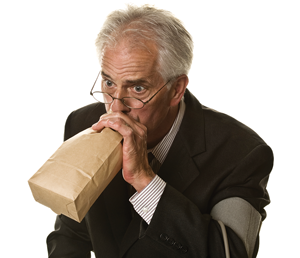2.2 Anxiety disorders
When a person has a panic attack they breathe fast and deep, exhaling a lot of carbon dioxide (CO2) so they will feel faint. If they blow into a paper bag and then re-breathe from the paper bag they take in some of the CO2. It helps to slow down the breathing so the person feels better.
As the name suggests, anxiety disorders occur where the person feels unusually anxious, either in the short term or for a prolonged period. There are several types of anxiety disorder:
- General anxiety disorder in which the person feels fearful or anxious for a long time but without any obvious cause.
- Panic disorder in which the person has panic attacks that can be unpredictable.
- Phobias, which are an intense fear of something that triggers anxiety.
- Obsessive compulsive disorder (OCD), which causes the person to have intrusive thoughts or urges to do something, such as clean excessively, and an overwhelming desire or compulsion to repeat tasks such as check locks or flush the toilet.
- Post-traumatic stress disorder (PTSD) is an anxiety associated with a bad experience in which the person relives the fear and anxiety that they felt during that bad experience.
2.1 Mood disorders

